Recurrent Neural Networks Based Photovoltaic Power Forecasting Approach
Abstract
:1. Introduction
- (1)
- In this paper, the PV power correlation of adjacent days is verified and analyzed.
- (2)
- The RNN model is introduced and tailored to fully extract high-level non-linear features hidden in the inter-day and intra-day power data.
- (3)
- For the first time, a novel PV power forecasting method based on adjacent days and intra-day data is proposed to mitigate the effects of the nonlinearity features that exist in the PV output power series on the prediction accuracy.
2. Recurrent Neural Networks
2.1. RNN Model
2.2. Parameter Learning Procedures of RNN
3. Adjacent Days and Intra-day Point Forecasting Model Based on RNN
3.1. Adjacent Days and Intra-day Data
3.2. Data Processing
3.3. Forecasting Model Based on RNN
3.4. Forecasting Performance Evaluation
4. Case Study and Discussions
4.1. 15-Min Ahead Forecasting Results
4.2. 30-Min Ahead Forecasting Results
4.3. The Forecasting Results for Multi-step Ahead
4.4. The Stability and Robustness of Forecasting Model
5. Conclusions
Author Contributions
Funding
Conflicts of Interest
Nomenclature
| Abbreviations | |
| PV | Photovoltaic |
| RNN | Recurrent neural network |
| ANN | Artificial neural network |
| BPNN | Backpropagation neural network |
| RBF | Radial basis function |
| SVM | Support vector machine |
| LSTM | Long short-term memory networks |
| LSTM-RNN | Long-short term memory recurrent neural network |
| NWP | Numerical weather prediction |
| SOM | Self-organized map |
| BPTT | Back propagation through time |
| MAE | Mean absolute error |
| RMSE | Root mean square error |
| MAPE | Mean absolute percentage error |
| R2 | Coefficient of determination |
| Parameters | |
| t | Index of time step (t = 1, 2, …, τ) |
| τ | The last time step |
| st | The hidden state at step t |
| xt | The input variable at step t |
| yt | The output variable at step t |
| ot | A temporary variable, ot is only determined by the hidden state st |
| b, c | Bias vectors |
| f, g | Activation function |
| The weight matrix between the input layer and the hidden layer | |
| The weight matrix between the hidden layer and the hidden layer | |
| The weight matrix between the hidden layer and the output layer | |
| lx, ls, lo | The number of neurons in the input layer, hidden layer and output layer. |
| L | The total cost of all time sequences |
| Lt | The sub-cost at the current step t |
| δt | The hidden state gradient of step t |
| diag(.) | The diag(.) stands for creating a diagonal matrix from a given vector |
| η | The learning rate of RNN |
| k | An interval value representing the number of days between the ith day and the jth day |
| Pi | The PV output power for the ith day |
| pim | A power point of the ith day |
| M | The length of the daily data |
| n | The number of days in the whole year |
| cij | The trend similarity degree of daily power between the ith day and the jth day |
| rij | The correlation coefficient of daily power between the ith day and the jth day |
| ck | The average values of cosine similarity cij in k-day intervals |
| rk | The average correlation coefficient rij in k-day intervals |
| The mean value of the ith daily data | |
| d | The number of the historical days adjacent the forecasting day |
| m | The number of PV power point selected in the forecasting day |
| xf(h) | The power at time h of the forecasting day |
| xf- 1(h + 1) | The power at time h+1 of the day before the forecasting day |
| xf(h + 1) | The predicted power for the forecasting model |
| yt, yt + 1 | The expected output in the forecasting model |
| xmin, xmax | The maximum and minimum of the historical output power data |
| N | The number of test data |
| Pia | The measured power at the ith sample |
| Pif | The predicted power at the ith sample |
| Pmean | The average of the total measured power |
References
- Sahu, B.K. A study on global solar PV energy developments and policies with special focus on the top ten solar PV power producing countries. Renew. Sustain. Energy Rev. 2015, 43, 621–634. [Google Scholar] [CrossRef]
- Sobri, S.; Koohi-Kamali, S.; Rahim, N.A. Solar photovoltaic generation forecasting methods: A review. Energy Convers. Manag. 2018, 156, 459–497. [Google Scholar] [CrossRef]
- Antonanzas, J.; Osorio, N.; Escobar, R.; Urraca, R.; Martinez-De-Pison, F.J.; Antonanzas-Torres, F. Review of photovoltaic power forecasting. Sol. Energy 2016, 136, 78–111. [Google Scholar] [CrossRef]
- Riffonneau, Y.; Bacha, S.; Barruel, F.; Ploix, S. Optimal power flow management for grid connected PV systems with batteries. IEEE Trans. Sustain. Energy 2011, 2, 309–320. [Google Scholar] [CrossRef]
- Mohamed, A.; Salehi, V.; Ma, T.; Mohammed, O. Real-time energy management algorithm for plug-in hybrid electric vehicle charging parks involving sustainable energy. IEEE Trans. Sustain. Energy 2014, 5, 577–586. [Google Scholar] [CrossRef]
- Chen, C.; Duan, S.; Cai, T.; Liu, B.; Hu, G. Smart energy management system for optimal microgrid economic operation. IET Renew. Power Gener. 2011, 5, 258–267. [Google Scholar] [CrossRef]
- Chen, X.; Du, Y.; Wen, H. Forecasting based power ramp-rate control for pv systems without energy storage. In Proceedings of the 2017 IEEE 3rd International Future Energy Electronics Conference and ECCE Asia (IFEEC 2017-ECCE Asia), Kaohsiung, Taiwan, 27 July 2017; pp. 733–738. [Google Scholar]
- Litjens, G.; Worrell, E.; van Sark, W. Assessment of forecasting methods on performance of photovoltaic-battery systems. Appl. Energy 2018, 221, 358–373. [Google Scholar] [CrossRef]
- Kikusato, H.; Mori, K.; Yoshizawa, S.; Fujimoto, Y.; Asano, H.; Hayashi, Y.; Kawashima, A.; Inagaki, S.; Suzuki, T. Electric vehicle charge-discharge management for utilization of photovoltaic by coordination between home and grid energy management systems. IEEE Trans. Smart Grid 2018, 10, 3186–3197. [Google Scholar] [CrossRef]
- Ming, M.; Wang, R.; Zha, Y.; Zhang, T. Multi-objective optimization of hybrid renewable energy system using an enhanced multi-objective evolutionary algorithm. Energies 2017, 10, 674. [Google Scholar] [CrossRef]
- Wang, G.; Zhang, X.; Wang, H.; Peng, J.-C.; Jiang, H.; Liu, Y.; Wu, C.; Xu, Z.; Liu, W. Robust Planning of Electric Vehicle Charging Facilities with an Advanced Evaluation Method. IEEE Trans. Ind. Inform. 2018, 14, 866–876. [Google Scholar] [CrossRef]
- Giorgi, M.G.D.; Congedo, P.M.; Malvoni, M.; Laforgia, D. Error analysis of hybrid photovoltaic power forecasting models: A case study of mediterranean climate. Energy Convers. Manag. 2015, 100, 117–130. [Google Scholar] [CrossRef]
- Inman, R.H.; Pedro, H.T.C.; Coimbra, C.F.M. Solar forecasting methods for renewable energy integration. Prog. Energy Combust. Sci. 2013, 39, 535–576. [Google Scholar] [CrossRef]
- Xu, R. The restriction research for urban area building integrated grid-connected PV power generation potential. Energy 2016, 113, 124–143. [Google Scholar]
- Wang, F.; Mi, Z.; Su, S.; Zhao, H. Short-term solar irradiance forecasting model based on artificial neural network using statistical feature parameters. Energies 2012, 5, 1355–1370. [Google Scholar] [CrossRef]
- Wang, H.Z.; Wang, G.B.; Li, G.Q.; Peng, J.C.; Liu, Y.T.; Yan, J. Deep belief network based deterministic and probabilistic wind speed forecasting approach. Appl. Energy 2016, 182, 80–93. [Google Scholar] [CrossRef]
- Hong, Y.-Y.; Yu, T.-H.; Liu, C.-Y. Hour-ahead wind speed and power forecasting using empirical mode decomposition. Energies 2013, 6, 6137–6152. [Google Scholar] [CrossRef]
- Gotleyb, D.; Sciuto, G.L.; Napoli, C.; Shikler, R.; Tramontana, E.; Woźniak, M. Characterisation and modeling of organic solar cells by using radial basis neural networks. In Proceedings of the International Conference on Artificial Intelligence and Soft Computing, Zakopane, Poland, 12–16 June 2016; Springer: Berlin, Germany; pp. 91–103. [Google Scholar]
- Połap, D.; Woźniak, M.; Wei, W.; Damaševičius, R. Multi-threaded learning control mechanism for neural networks. Fut. Gen. Comput. Syst. 2018, 87, 16–34. [Google Scholar]
- Aderemi, O.; Misra, S.; Ahuja, R. Energy Consumption Forecast Using Demographic Data Approach with Canaanland as Case Study. In Proceedings of the International Conference on Next Generation Computing Technologies, Dehradun, India, 30–31 October 2017; pp. 641–652. [Google Scholar]
- Beritelli, F.; Capizzi, G.; Sciuto, G.L.; Scaglione, F.; Połap, D.; Woźniak, M. A neural network pattern recognition approach to automatic rainfall classification by using signal strength in LTE/4G networks. In Proceedings of the International Joint Conference on Rough Sets, Olsztyn, Poland, 3–7 July 2017; Springer: Berlin, Germany; pp. 505–512. [Google Scholar]
- Sciuto, G.L.; Capizzi, G.; Caramagna, A.; Famoso, F.; Lanzafame, R.; Woźniak, M. Failure Classification in High Concentration Photovoltaic System (HCPV) by using Probabilistic Neural Networks. Int. J. Appl. Eng. Res. 2017, 12, 16039–16046. [Google Scholar]
- Pedro, H.T.C.; Coimbra, C.F.M. Assessment of forecasting techniques for solar power production with no exogenous inputs. Sol. Energy 2012, 86, 2017–2028. [Google Scholar] [CrossRef]
- Zhu, H.; Lian, W.; Lu, L.; Dai, S.; Hu, Y. An improved forecasting method for photovoltaic power based on adaptive BP neural network with a scrolling time window. Energies 2017, 10, 1542. [Google Scholar] [CrossRef]
- Shi, J.; Lee, W.J.; Liu, Y.; Yang, Y.; Wang, P. Forecasting Power Output of Photovoltaic Systems Based on Weather Classification and Support Vector Machines. IEEE Trans. Ind. Appl. 2015, 48, 1064–1069. [Google Scholar] [CrossRef]
- Wu, C.; Mohsenian-Rad, H.; Huang, J. Vehicle-to-aggregator interaction game. IEEE Trans. Smart Grid 2011, 3, 434–442. [Google Scholar] [CrossRef]
- Ugurlu, U.; Oksuz, I.; Tas, O. Electricity price forecasting using recurrent neural networks. Energies 2018, 11, 1255. [Google Scholar] [CrossRef]
- Yona, A.; Senjyu, T.; Funabashi, T. Application of Recurrent Neural Network to Short-Term-Ahead Generating Power Forecasting for Photovoltaic System. In Proceedings of the Power Engineering Society General Meeting, Tampa, FL, USA, 24–28 June 2007; pp. 1–6. [Google Scholar]
- Yadav, A.P.; Kumar, A.; Behera, L. RNN Based Solar Radiation Forecasting Using Adaptive Learning Rate. In Proceedings of the International Conference on Swarm Evolutionary and Memetic Computing, Chennai, India, 19–21 December 2013; Springer: Berlin, Germany, 2013; pp. 442–452. [Google Scholar]
- Abdel-Nasser, M.; Mahmoud, K. Accurate photovoltaic power forecasting models using deep LSTM-RNN. Neural Comput. Appl. 2017, 1–14. [Google Scholar] [CrossRef]
- Goodfellow, I.; Bengio, Y.; Courville, A. Deep Learning; The MIT Press: London, UK, 2016. [Google Scholar]
- Elia, Belgium’s Electricity Transmission System Operator. Available online: http://www.elia.be/en/grid-data/power-generation/Solar-power-generation-data/Graph (accessed on 31 December 2014).
- He, Y.-J.; Zhu, Y.-C.; Gu, J.-C.; Yin, C.-Q. Similar day selecting based neural network model and its application in short-term load forecasting. In Proceedings of the 2005 International Conference on Machine Learning and Cybernetics, Guangzhou, China, 18–21 August 2005; pp. 4760–4763. [Google Scholar]
- Sun, X.; Luh, P.B.; Cheung, K.W.; Guan, W.; Michel, L.D.; Venkata, S.; Miller, M.T. An efficient approach to short-term load forecasting at the distribution level. IEEE Trans. Power Syst. 2016, 31, 2526–2537. [Google Scholar] [CrossRef]
- Wang, H.; Yi, H.; Peng, J.; Wang, G.; Liu, Y.; Jiang, H.; Liu, W. Deterministic and probabilistic forecasting of photovoltaic power based on deep convolutional neural network. Energy Convers. Manag. 2017, 153, 409–422. [Google Scholar] [CrossRef]
- Yang, C.; Thatte, A.A.; Xie, L. Multitime-scale data-driven spatio-temporal forecast of photovoltaic generation. IEEE Trans. Sustain. Energy 2014, 6, 104–112. [Google Scholar] [CrossRef]
- Shah, A.S.B.M.; Yokoyama, H.; Kakimoto, N. High-precision forecasting model of solar irradiance based on grid point value data analysis for an efficient photovoltaic system. IEEE Trans. Sustain. Energy 2015, 6, 474–481. [Google Scholar] [CrossRef]
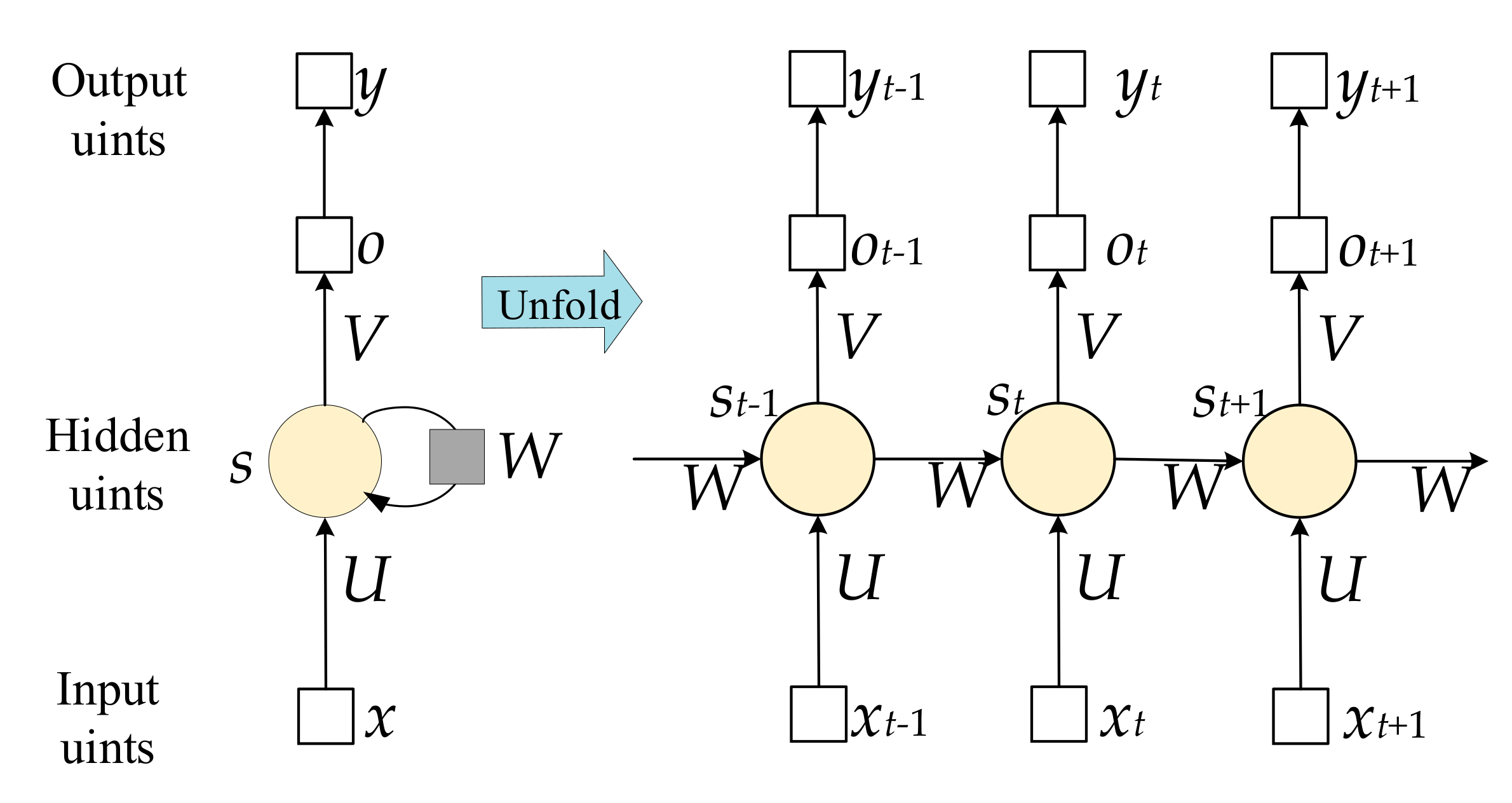
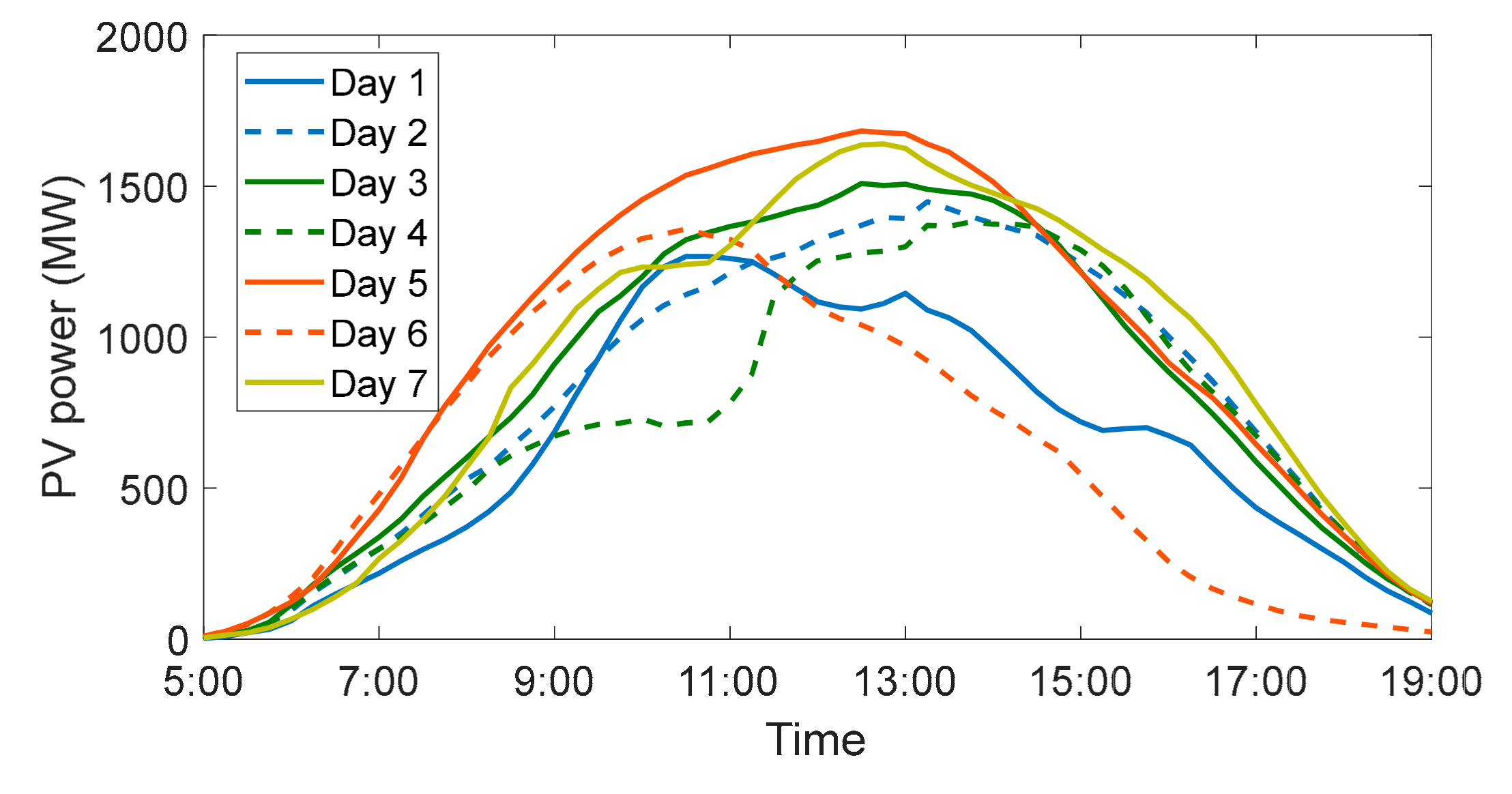
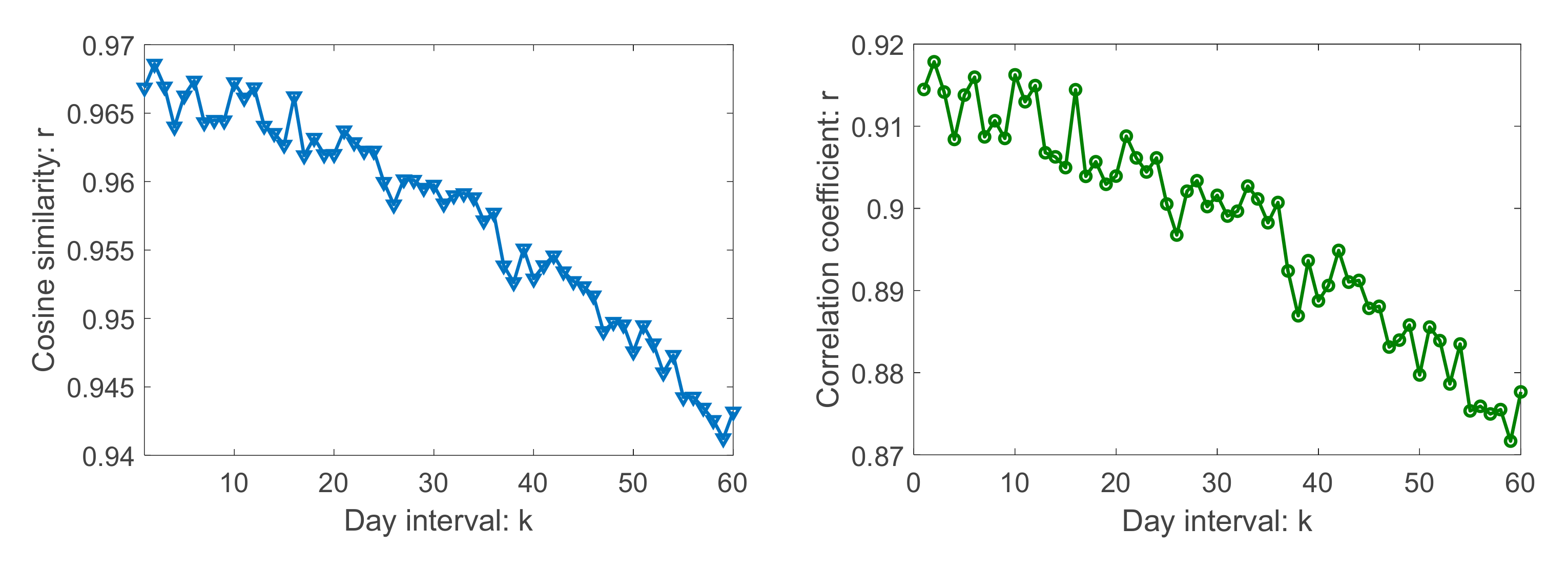


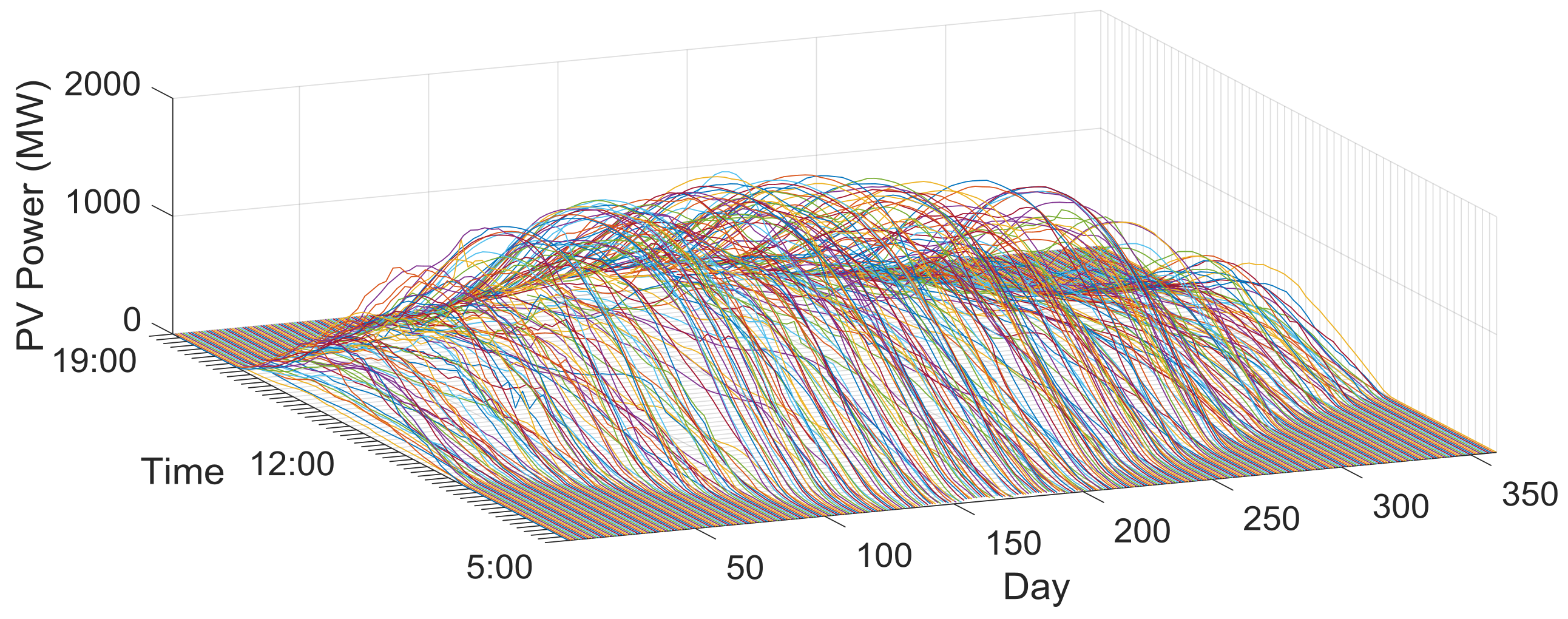
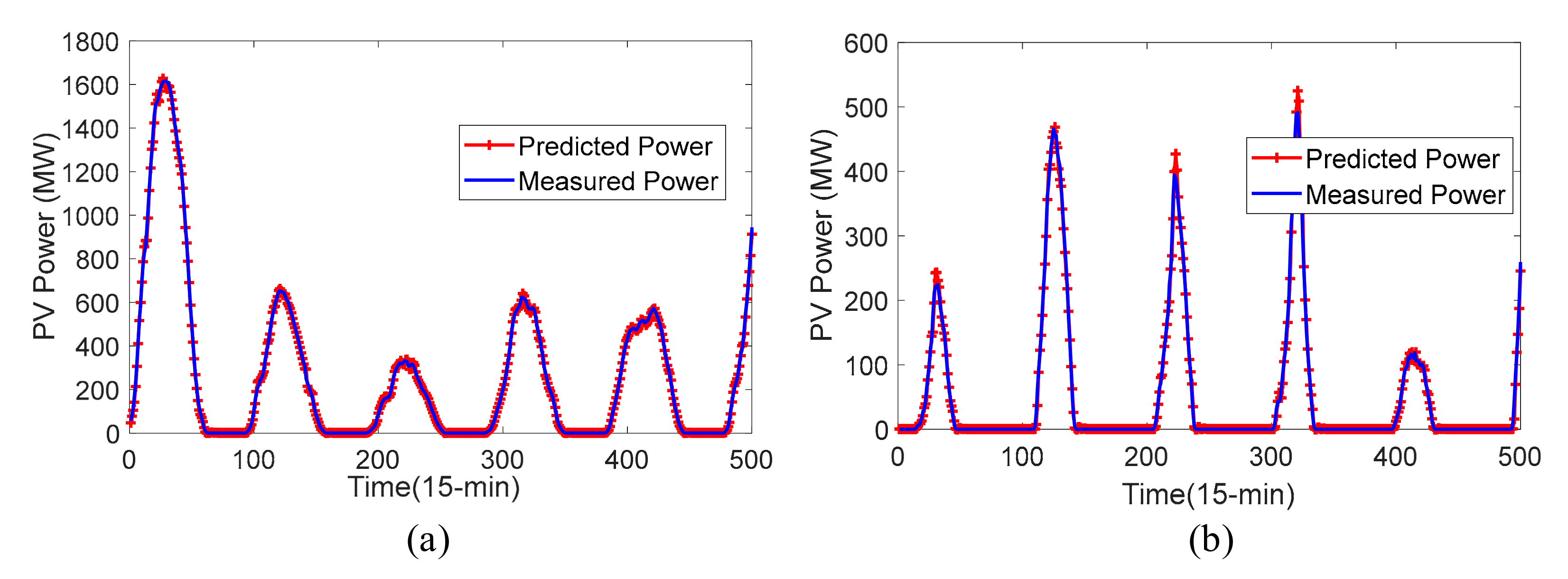
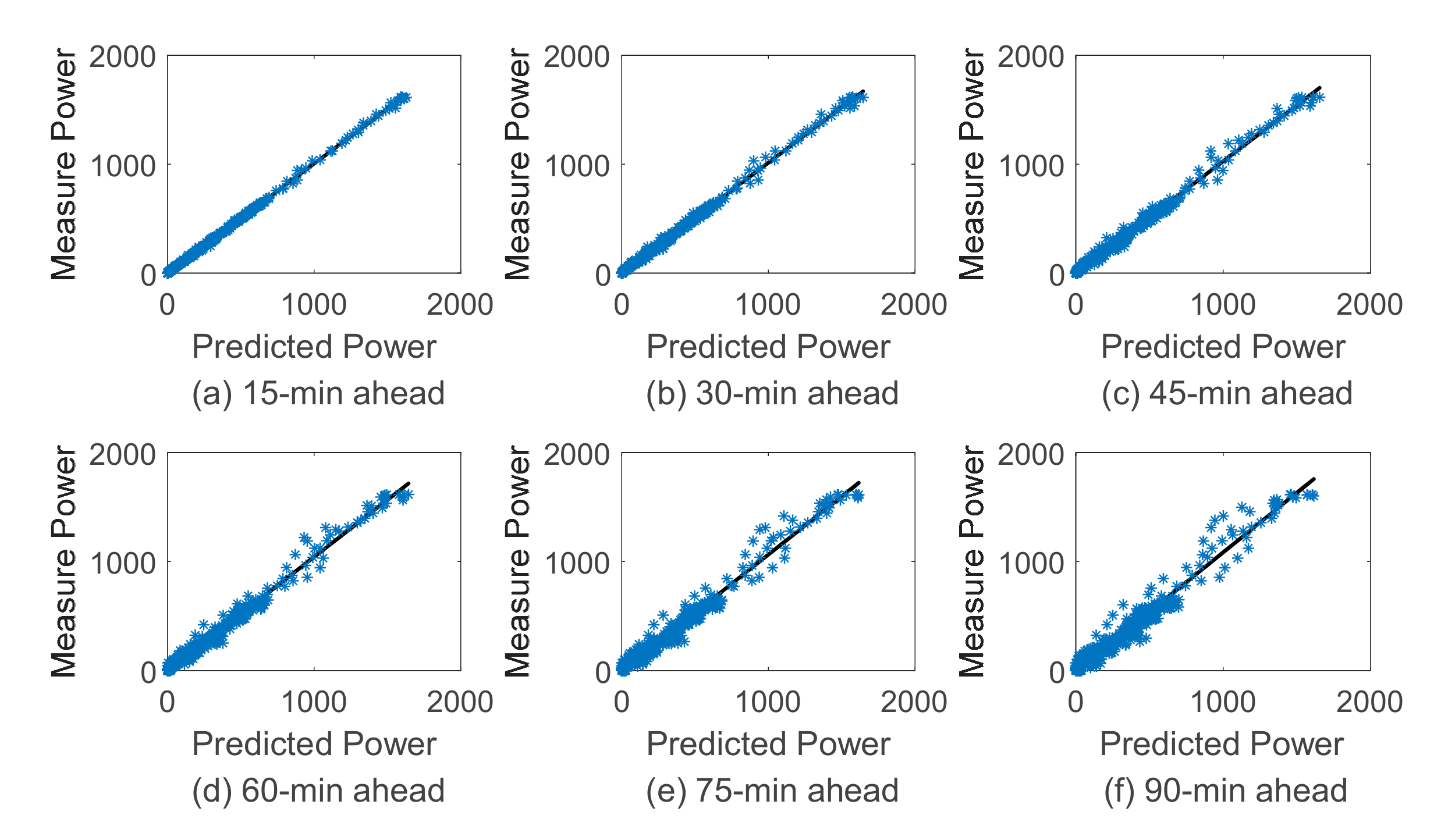


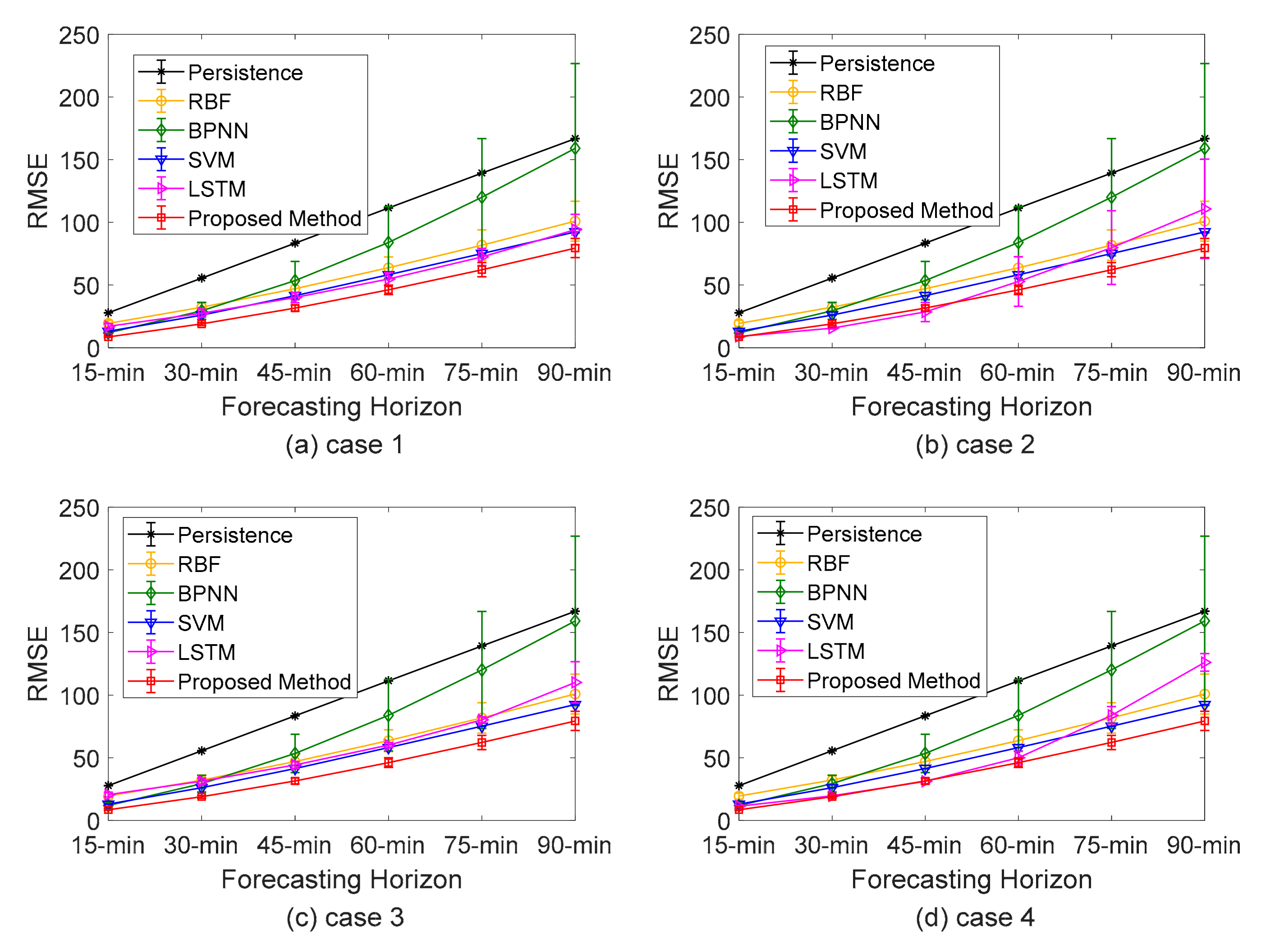
| Case | Error | Persistence | RBF | BPNN | SVM | LSTM | Proposed Method |
|---|---|---|---|---|---|---|---|
| case 1 | MAE | 17.16 | 13.47 | 7.86 | 9.98 | 10.96 | 5.22 |
| RMSE | 27.85 | 18.31 | 11.52 | 13.02 | 16.11 | 8.35 | |
| MAPE | 6.37% | 5.01% | 2.92% | 3.71% | 4.07% | 1.94% | |
| case 2 | MAE | 7.34 | 7.24 | 5.36 | 5.85 | 4.35 | 3.44 |
| RMSE | 15.41 | 12.54 | 10.18 | 8.56 | 8.70 | 7.35 | |
| MAPE | 13.59% | 13.39% | 9.40% | 10.82% | 8.04% | 6.36% | |
| case 3 | MAE | 30.10 | 18.26 | 9.30 | 10.97 | 12.05 | 6.58 |
| RMSE | 45.34 | 27.35 | 14.25 | 14.46 | 19.82 | 10.95 | |
| MAPE | 7.07% | 4.29% | 2.18% | 2.58% | 2.83 | 1.54% | |
| case 4 | MAE | 15.80 | 9.85 | 6.52 | 7.60 | 6.72 | 4.17 |
| RMSE | 29.36 | 15.45 | 10.20 | 9.88 | 11.36 | 6.97 | |
| MAPE | 8.64% | 5.39% | 3.57% | 4.15% | 3.67% | 2.28% | |
| Average | MAE | 17.60 | 12.21 | 7.26 | 8.60 | 8.52 | 4.85 |
| RMSE | 29.49 | 18.41 | 11.54 | 11.48 | 13.99 | 8.40 | |
| MAPE | 8.92% | 7.02% | 4.52% | 5.31% | 4.65% | 3.03% |
| Case | Error | Persistence | RBF | BPNN | SVM | LSTM | Proposed Method |
|---|---|---|---|---|---|---|---|
| case 1 | MAE | 34.35 | 21.46 | 21.03 | 20.06 | 17.81 | 11.90 |
| RMSE | 55.61 | 29.27 | 28.73 | 26.13 | 26.50 | 18.28 | |
| MAPE | 12.67% | 7.91% | 7.76% | 7.40% | 6.57% | 4.39% | |
| case 2 | MAE | 14.63 | 12.61 | 9.56 | 12.17 | 7.51 | 6.87 |
| RMSE | 30.16 | 21.56 | 19.34 | 16.99 | 15.75 | 14.27 | |
| MAPE | 26.75% | 23.06% | 17.49% | 22.25% | 13.73% | 12.56% | |
| case 3 | MAE | 60.09 | 30.04 | 22.65 | 22.67 | 18.50 | 13.89 |
| RMSE | 90.15 | 44.83 | 33.56 | 29.49 | 30.34 | 22.96 | |
| MAPE | 14.04% | 7.02% | 5.29% | 5.29% | 4.32% | 3.24% | |
| case 4 | MAE | 31.52 | 16.80 | 16.71 | 16.22 | 11.66 | 9.36 |
| RMSE | 58.31 | 26.25 | 25.26 | 20.62 | 20.11 | 15.29 | |
| MAPE | 17.21% | 9.17% | 9.12% | 8.85% | 6.36% | 5.11% | |
| Average | MAE | 35.15 | 20.23 | 17.49 | 17.78 | 13.87 | 10.51 |
| RMSE | 58.56 | 30.48 | 26.72 | 23.30 | 23.18 | 17.70 | |
| MAPE | 17.67% | 11.79% | 9.91% | 10.95% | 7.74% | 6.33% |
| Case | Coefficient | 15-min | 30-min | 45-min | 60-min | 75-min | 90-min |
|---|---|---|---|---|---|---|---|
| case 1 | R2 | 0.9994 | 0.9975 | 0.9938 | 0.9881 | 0.9800 | 0.9699 |
| case 2 | R2 | 0.9954 | 0.9828 | 0.9619 | 0.9296 | 0.8864 | 0.8359 |
© 2019 by the authors. Licensee MDPI, Basel, Switzerland. This article is an open access article distributed under the terms and conditions of the Creative Commons Attribution (CC BY) license (http://creativecommons.org/licenses/by/4.0/).
Share and Cite
Li, G.; Wang, H.; Zhang, S.; Xin, J.; Liu, H. Recurrent Neural Networks Based Photovoltaic Power Forecasting Approach. Energies 2019, 12, 2538. https://doi.org/10.3390/en12132538
Li G, Wang H, Zhang S, Xin J, Liu H. Recurrent Neural Networks Based Photovoltaic Power Forecasting Approach. Energies. 2019; 12(13):2538. https://doi.org/10.3390/en12132538
Chicago/Turabian StyleLi, Gangqiang, Huaizhi Wang, Shengli Zhang, Jiantao Xin, and Huichuan Liu. 2019. "Recurrent Neural Networks Based Photovoltaic Power Forecasting Approach" Energies 12, no. 13: 2538. https://doi.org/10.3390/en12132538
APA StyleLi, G., Wang, H., Zhang, S., Xin, J., & Liu, H. (2019). Recurrent Neural Networks Based Photovoltaic Power Forecasting Approach. Energies, 12(13), 2538. https://doi.org/10.3390/en12132538





